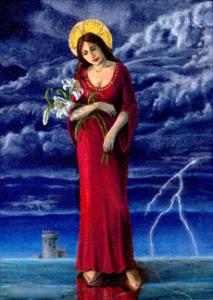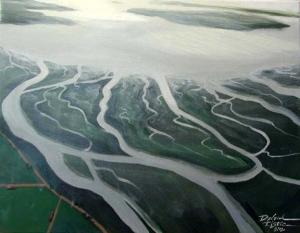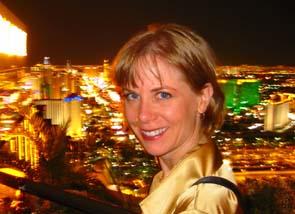Deb Ristic is a Flame designer & storyboard artist at Modern Digital in Seattle, Washington. She joinned from BB&J, Los Angeles, where she was working on visual effects for such television series as Third Watch. Ristic works extensively with both Painter software for concept art and storyboarding, and follows projects through to Flame compositing.
FXG: How did you start out?
DR: I started my career as a storyboard illustrator in fact. I studied with the venerable Harold Michelson (“Birds”, “Ten Commandments”), David Negron Sr. (“Raiders of the Lost Ark”, “Tora Tora Tora”) and Marty Kline “Who Framed Roger Rabbit”, “Altered States.” I hung out in the studio art departments, they showed me their work, and they would give me pieces of script to storyboard. I’d come back later to show them, and they would critique my work. They taught me how to do a 3d illustration of a set, using the blueprints, camera information such as lens, height, or format such as vista vision or scope – all without a computer. It showed perspective, framing, and how much of a set could be seen with a particular lens. It was very technical drawing that people today pretty much exclusively use a computer to do. But those technical illustrations, as well as continuity boards, were an important part of the job of a storyboard illustrator.
Some storyboard illustrators, like Harold, used charcoal. That gave a lot of mood to the story that unfolded in the boards. Marty liked using pen and markers. I’ve used pencil, markers, charcoal, and pens. This was all before the popularity of desktop computers.

FXG: When did you start using painter?
DR: I think it was version 3 or 4, I started using it… It was for my first freelance job creating interactive artwork for an educational cd rom. What struck me was the vastness of the brush collection. It was unparelleled to any other paint program out there, even the higher end systems like Paintbox and flame.
FXG: Do you find the most clients expect this level of pre-production – or are they excited to have visuals so early in the process?
DR: Clients are very excited to see boards with this level of quality. A lot of times, my client is a director, who must then take the boards and pitch them to his/her client. Some of those clients have difficulty visualizing, so it has been important to these directors, that I be specific in terms of the visuals. Color and shading has been a critical part of that. One director came in with pictures of the location, head shots of the talent, and catalogs of the clothing, and I had to put them all together to let his client (a department store) know precisely on a visual and sequential level, what was going to happen in the spot. The client loved the boards, and when the final spot was shot and put together, there were no surprises. It went as smooth as silk, and the client was very happy with the results.

FXG: Does it help with colour design and colour palettes in telecine to
have such expressive storyboards and concept art?
DR: Yes. When doing color boards, I always ask what palette are we working with. Golds? Blues? Cyans? That will get translated into the boards for the client as well. That mandate will follow right through to telecine and final conform. We’ve had to change color scheme on a campaign, and it was easy to do while still in the storyboarding phase.
FXG: Does doing concept art and storyboards help later when your
compositing complex shots?
DR: Yes. Very much so. A lot of times I’ve called into do boards, and I have to take some very abstract concepts and interpret them visually. One meeting I took, I just wrote down words and concepts. From those notes, I came up with some visuals to see if we were in the ballpark. From there we revised, and ultimately scanned the storyboards, and cut together an animatic using flame. So from those boards, we got the concept, design, sequence, and timing. The boards were critical in helping determine how it would be shot, as the the piece was a pretty fx laden and required motion control.
I’ve also always done storyboards for title design. It’s absolutely essential to have some sketches that show sequential action, or tell a story, or even show a progression. From those, we usually pick a frame to flush out as a “style frame”, which more closely represents how the footage will actually look.
For commercial work, it’s mostly to help directors communicate better with their clients, and show them what they’re thinking.
FXG: How many versions do you tend to do of any sketch ?
DR: Two at most

FXG: Given that your a very successful traditional artist, how does the
Painter experience compare to traditional media?
DR: Most art directors of long ago remember the age of marker comps. I had one of those guys swear that the boards I did in Painter, were actual marker comps.
The wonderful thing about the way I do boards using Painter, is that if the client wants to change the color scheme of any sequence, I don’t have to redraw everything.
FXG: Is the electronic version as expressive?
DR: I think its close. I don’t think electronic painting will ever surpass the intrinsic value of a painting on canvas. There’s some thing magical about traditional media… maybe it’s because there’s no “undo” button.
FXG: Do you take into count lens- framing and composition or is it more expressive and loose at this early stage?
DR: For matte paintings, I always hope I’ve been consulted before its been shot, as far as advice to make it all go smoothly. In those cases, I do advise attention be payed to camera angle, lens framing, etc. But sometimes, that’s not an option. In those cases, sometimes I have to do some research, or shoot my own elements to make it work.

DR: I think with any craft, it’s important to do your homework. I think my knowledge of perspective and camera angles from my early days with the experts really helps me adequately communicate what directors want to see. A computer is a tool, like a brush or a marker. It won’t draw the boards for you, it won’t design the piece for you, but it can help breath some excitement into your work. It streamlines workflow, and makes the task at hand a lot easier, especially for those who need the flexibility of revisions.
Deb Ristic
